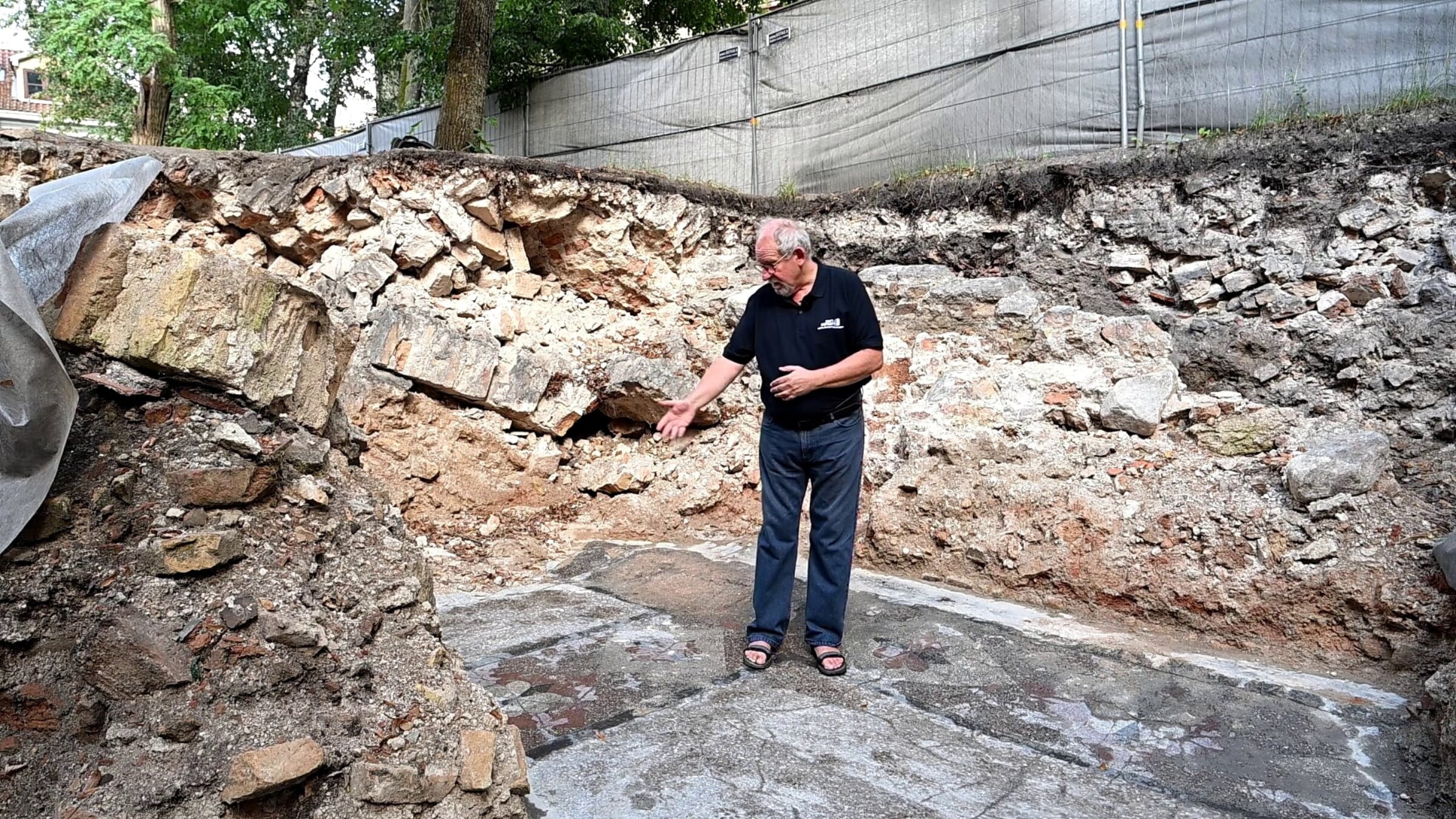Archeologists uncover floor of the Great Synagogue of Vilna, destroyed by the Nazis and Soviets
The synagogue formed the heart of a once-thriving Jewish community that was virtually obliterated during the Holocaust

Jon Seligman of the Israel Antiquities Authority stands on the colorful floor of the main prayer hall of the Great Synagogue of Vilna, which was destroyed by the Nazis and has been undergoing excavation since 2015. (Israel Antiquities Authority) Photo by Israeli Antiquities
(JTA) — A new excavation has unearthed parts of the Great Synagogue of Vilna, once the oldest and most important building for Lithuanian Jews before it was destroyed by the Nazis and razed by the Soviets.
Archeologists found the synagogue floor decorated with red, black and white flowers, along with the remains of a vibrant wall painted in red and blue, they said on Thursday. They also uncovered part of the women’s gallery, water reservoirs used for the mikvah (or ritual bath) and a large pillar that once flanked the bimah (or prayer platform), now collapsed on its side.
This latest excavation is the fifth in a series that began in 2015, when a ground-penetrating radar first traced remnants of the synagogue. Previous sessions revealed the bimah, the Torah ark and Torah scroll and a Hebrew inscription. The project is led by the Israel Antiquities Authority, the Association of Lithuanian Archeology, the Good Will Foundation and Lithuania’s Jewish community.
“The magnificent remains we are discovering — the synagogue bimah that was uncovered during the previous excavation seasons, as well as the colorful decorations of the floor and walls — bring back moments in the life of a lost vibrant community,” said the excavation directors, Jon Seligman of the Israel Antiquities Authority and Justinas Rakas of the Lithuanian Archeological Society, in a statement.
The Great Synagogue of Vilna, now known as Vilnius in Lithuania, was built in the 17th century in a Renaissance-Baroque style and formed the heart of a thriving Jewish community. Before the Holocaust, the synagogue was surrounded by a complex filled with Jewish life, including 12 synagogues, study houses, kosher meat stalls, a bathhouse and the famous Strashun Library, one of the most important Jewish cultural institutions in Eastern Europe before its destruction in World War II.
Lithuania’s Jews had a distinct culture, including their own dialect of Yiddish, and played a profound role in developing Jewish thought. Vilnius attracted many celebrated Yiddish writers and scholars, earning it a nickname as the “Jerusalem of the North.”
During the Holocaust, the Nazis killed over 90% of Lithuanian Jews and looted and burned the Great Synagogue. After Lithuania came under Communist control, Soviet authorities demolished the synagogue’s remnants in the 1950s and built a school on its site.
Soviet rule, which lasted until 1990, delayed any reckoning with the country’s Holocaust history, both the destruction wrought by the Nazis and the role that local collaborators played. Only in the last few years has the country allocated any funding to survivors of the Holocaust in Lithuania.
A message from our CEO & publisher Rachel Fishman Feddersen
I hope you appreciated this article. Before you go, I’d like to ask you to please support the Forward’s award-winning, nonprofit journalism during this critical time.
We’ve set a goal to raise $260,000 by December 31. That’s an ambitious goal, but one that will give us the resources we need to invest in the high quality news, opinion, analysis and cultural coverage that isn’t available anywhere else.
If you feel inspired to make an impact, now is the time to give something back. Join us as a member at your most generous level.
— Rachel Fishman Feddersen, Publisher and CEO